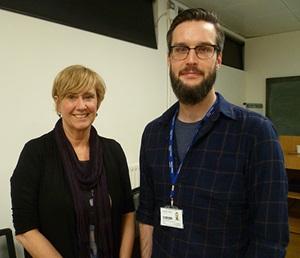Lighting the path to faster bug detection
One study is developing an easy, at-home detection test, while the other is working towards a test that’s so quick people with cystic fibrosis (CF) can take a test at the beginning of an appointment and find out what bugs they have at the end. We’ve put together a handy comparison to help you understand the two studies, how the science works, the tricky bits and how the researchers became involved in this cutting-edge CF research.
What's the concept and how does it work?
Developing a home monitoring test
The goal of this research is to create a test the same size and shape as a pregnancy test that can detect common bugs that people with CF are growing in their lungs. At the same time, this test could show which antibiotics the bugs are resistant to (one stick for each type of infection). If a bug is present, the test will light up or change colour. The method used is a miniaturised version of the detection method used in the lab.
On the antibiotic resistant side of the test, if there is no colour, no bug is growing. In other words if there is no colour then antibiotics are likely to be effective. The opposite is true if there is a colour: this shows that the bug is resistant to the antibiotic.
The researchers will be developing these tests for the next few years, and when they’ve got them working, they could potentially be used to test for Pseudomonas and other important bugs at home.
Quicker tests in the clinic
The researchers in this project are making use of the fact that the bugs that infect the lungs of people with CF are themselves prone to infection. These bugs are infected by a particular type of virus called bacteriophages.
Researchers are fluorescently tagging these bacteriophages so that as they spread the brightness of the fluorescence increases, and the bug lights up enough to be detected.
The idea is that if someone with CF takes a test at the start of their clinic visit, then by the end of their visit a few hours later they would get confirmation of which type and strain of bugs are present in their lungs, and could agree a course of action with their CF team straight away.
This idea has already been shown to work for other bugs, such as Salmonella in food – detecting it in a few hours. Now the research team wants to develop the method for detecting CF bugs such as Pseudomonas.
Who is working on these research projects?

Developing a home monitoring test
This is a joint project, led by Dr Collin Sones at the University of Southampton and collaborating with the Trust-funded Pseudomonas Strategic Research Centre (SRC) led by Professor Jane Davies at Imperial College. One of the three main aims of the SRC is to improve methods for early detection of Pseudomonas. Ronan Murphy (pictured with Professor Davies) is working on this research project as part of his PhD within the SRC at Imperial College.
The idea for making a home monitoring test to detect bacterial infections started out as a project to look at urinary tract infections (UTIs). A collaboration between Professor Davies and Dr Sones developed after Jane gave a seminar at Southampton University, and the groups realised they had overlapping interests. The UTI project was extended to include Pseudomonas and Burkholderia cepacia complex infections.

Quicker tests in the clinic
Manchester Metropolitan University-based Professor Chris van der Gast and his PhD student Lauren Hatfield (pictured) are working on this project.
Prof van der Gast is a relative newcomer to CF research. He is more used to studying the interaction of many different types of bacteria in soil and water in the environment. After a collaboration with CF researchers at King’s College Hospital, Chris decided to focus more on cystic fibrosis.
He said: “I could see that this research could make a societal and economic difference for people with cystic fibrosis. It was a big opportunity to make an impact”.
What's the tricky bit?
Developing a home monitoring test
The cutting edge of this project is creating the channels in the dipstick for the sample to run along. In the lab, this complex detection technique is undertaken on a system about the size of an A5 piece of paper. In a home test, the test will need to work on a system the size of a postage stamp, with no help from the Borrowers or the people in the recent ‘Downsizing’ film!
Quicker tests in the clinic
Some of the bacteriophages are fussier than others about which bugs they will infect. Some will infect a range of different bugs, while others will only infect a specific type.
Lauren has begun her research by seeking out the bacteriophages that infect specific bugs known to cause lung infections. For example, those that will only infect Pseudomonas. The team is also looking to be able to identify different strains of bugs with this technique.
Who is co-funding this research?
Developing a home monitoring test
The majority of the funding for this research comes from a grant from the Engineering and Physical Sciences Research Council (EPSRC), who gave a grant of £786,000. The Trust provided additional funding of £90,000.
Quicker tests in the clinic
This research is co-funded between Manchester Metropolitan University and the Trust, with each organisation providing over £45,000.
Inspired by what you’ve read here? Please make a regular donation today to help us to continue funding vital research that is changing the lives of people with CF for the better.
